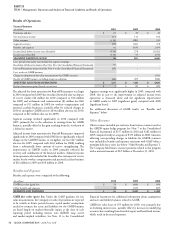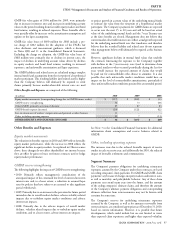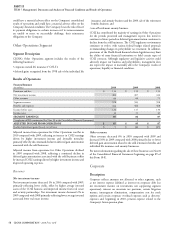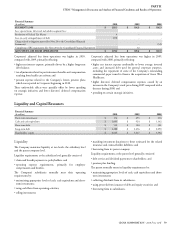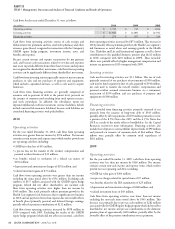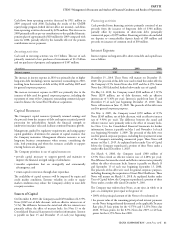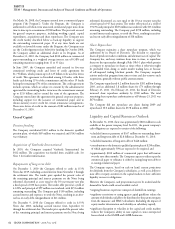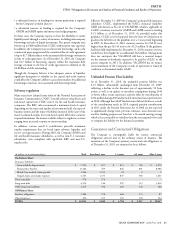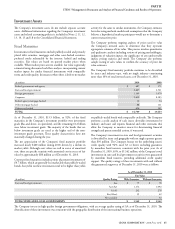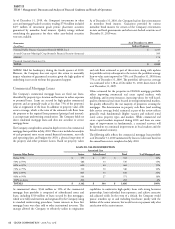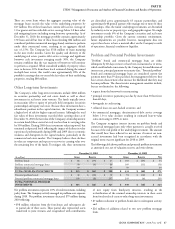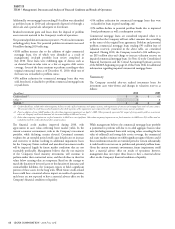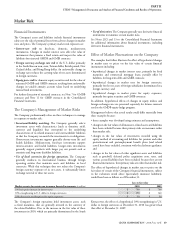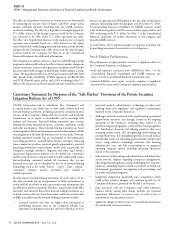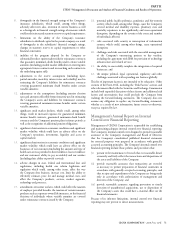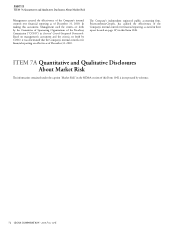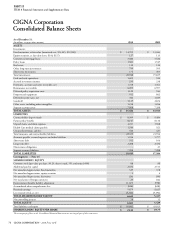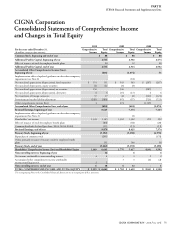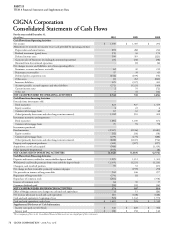Cigna 2010 Annual Report Download - page 86
Download and view the complete annual report
Please find page 86 of the 2010 Cigna annual report below. You can navigate through the pages in the report by either clicking on the pages listed below, or by using the keyword search tool below to find specific information within the annual report.
CIGNA CORPORATION 2010 Form 10K
66
PART II
ITEM 7 Management’s Discussion and Analysis of Financial Condition and Results of Operations
As of December 31, 2010, the Company’s investments in other
asset and mortgage-backed securities totaling $754 million included
$477 million of investment grade private placement securities
guaranteed by monoline bond insurers. Quality ratings without
considering the guarantees for these other asset-backed securities
were not available.
As of December 31, 2010, the Company had no direct investments
in monoline bond insurers. Guarantees provided by various
monoline bond insurers for certain of the Company’s investments
in state and local governments and other asset-backed securities as of
December 31, 2010 were:
Guarantor
(In millions)
As of December31,2010
Indirect Exposure
National Public Finance Guarantee (formerly MBIA, Inc.) $ 1,217
Assured Guaranty Municipal Corp (formerly Financial Security Assurance) 589
AMBAC 176
Financial Guaranty Insurance Co. 37
TOTAL $ 2,019
AMBAC fi led for bankruptcy during the fourth quarter of 2010.
However, the Company does not expect this action to materially
impact valuations of guaranteed securities given the high quality of
underlying issuer credit without this guaranteed support.
Commercial Mortgage Loans
e Company’s commercial mortgage loans are fi xed rate loans,
diversifi ed by property type, location and borrower to reduce exposure
to potential losses. Loans are secured by high quality commercial
property and are generally made at less than 75% of the property’s
value at origination of the loan. In addition to property value, debt
service coverage, which is the ratio of the estimated cash fl ows from
the property to the required loan payments (principal and interest),
is an important underwriting consideration. e Company holds no
direct residential mortgage loans and does not securitize or service
mortgage loans.
e Company completed its annual in depth review of its commercial
mortgage loan portfolio in July, 2010. is review included an analysis
of each property’s most recent annual fi nancial statements, rent rolls
and operating plans and budgets for 2010, a physical inspection of
the property and other pertinent factors. Based on property values
and cash fl ows estimated as part of this review, along with updates
for portfolio activity subsequent to the review, the portfolio’s average
loan-to-value ratio improved to 74% as of December 31, 2010 from
77% as of December 31, 2009. e portfolio’s debt service coverage
was estimated to be 1.38 as of December 31, 2010, down from 1.48
as of December 31, 2009.
Values estimated for the properties in CIGNA’s mortgage portfolio
refl ect improving commercial real estate capital markets, with
stabilizing, and in some instances, increasing values, for well leased,
quality commercial real estate located in strong institutional markets,
the quality refl ected by the vast majority of properties securing the
mortgages. e deterioration in property cash fl ows (and resulting
debt service coverage levels) estimated as part of the review refl ects
generally weak fundamentals (higher vacancy and reduced rental
rates) across property types and markets. While commercial real
estate capital markets improved during 2010 and there are some
signs of improvement in fundamentals, a sustained recovery will
be dependent on continued improvement in local markets and the
broader national economy.
e following table refl ects the commercial mortgage loan portfolio
as of December 31, 2010 summarized by loan-to-value ratio based on
the annual loan review completed in July, 2010.
LOANTOVALUE DISTRIBUTION
Loan-to-Value Ratios
Amortized Cost
% of Mortgage LoansSenior Subordinated Total
Below 50% $ 195 $ 157 $ 352 10%
50% to 59% 486 33 519 15%
60% to 69% 600 64 664 19%
70% to 79% 310 30 340 10%
80% to 89% 805 33 838 24%
90% to 99% 544 27 571 16%
100% or above 202 - 202 6%
TOTALS $ 3,142 $ 344 $ 3,486 100%
As summarized above, $344 million or 10% of the commercial
mortgage loan portfolio is comprised of subordinated notes and
loans, including $310 million of loans secured by fi rst mortgages,
which were fully underwritten and originated by the Company using
its standard underwriting procedures. Senior interests in these fi rst
mortgage loans were then sold to other institutional investors. is
strategy allowed the Company to eff ectively utilize its origination
capabilities to underwrite high quality loans with strong borrower
sponsorship, limit individual loan exposures, and achieve attractive
risk adjusted yields. In the event of a default, the Company would
pursue remedies up to and including foreclosure jointly with the
holders of the senior interests, but would receive repayment only after
satisfaction of the senior interest.


